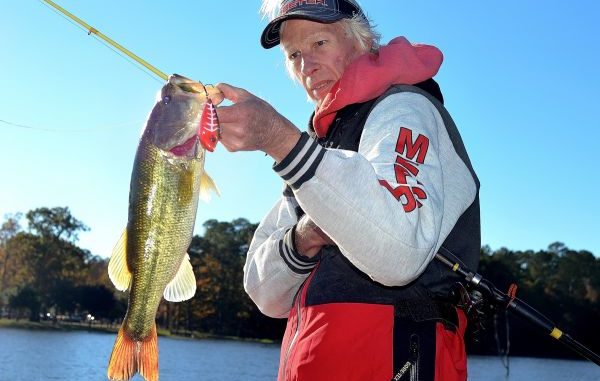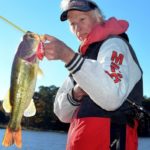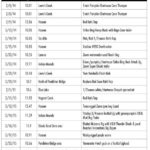
The Toledo Bend trophy bass parade should crank up this month, with lunkers feeding up for the upcoming spawn. And this longtime lake guide knows exactly how to catch them.
February marks the beginning of what has become a parade of huge largemouth at Toledo Bend Reservoir.
As water temperatures increase, fish move into the shallows to stake out prime nursery locations near points and deeper channels in preparation for the spawn.
But before they go to their beds, these big sows will be feeding up, feasting on baitfish and crawfish.
And that means this is a great time to target those double-digit bass that have come by the dozens over the past couple of years.
Guide and Louisiana Sportsman columnist John Dean Jr. will be on the water as often as possible, ambushing as many of these lunkers as possible.
The 62-year-old Dean — who has fished two Bassmaster Classic and earned numerous top 50 finishes on the Bassmaster trail — has fished the fabled reservoir for nearly 40 years.
And he said any trophy hunters should make the trip to the reservoir this month.
“February is a great time to be fishing Toledo Bend waters,” Dean said. “The lake is just a super-rich environment for largemouths right now, and they’ll be roaming in and out of the shallows to fatten up before the spawn.”
Louisiana Department of Wildlife and Fisheries biologist Jason Brancamp said the drive to binge eat is the first step in the annual breeding cycle.
“The prespawn is a preparatory time for bass before the spawn occurs,” Brancamp said. “Bass are getting into the mood, heading into the direction of the shallows.”
Increasing water temperature is the prime factor driving these fish to the shallows, according to the biologist.
“And these bass will be looking to chase the young (baitfish) of the previous year,” he said.
Dean is in general agreement with Brancamp — but added a caveat.
“The last two winters have been pretty brutal at Toledo Bend, and we have even experienced a couple of snows,” Dean said. “When you have water temperatures in the 40s for a long period, there’s not going to be much movement.”
This winter was pretty mild through early January, but the veteran angler said a frigid turn can slow down the migration.
“Let’s just say the prespawn starts in February,” Dean said. “It can extend into March or even April as groups of fish will move in and out due to cold fronts which still plague us as in the past two years.”
It is when water temperatures start moving into the mid-50s that Toledo Bend bass truly start moving shallow in earnest, he said.
“And it’s going to be an in-and-out migration,” he said. “If a front comes in, you can expect about three days of not catching followed by a few days of scoring on good fish until the next cold weather moves in.”
That means anglers have to look at the prespawn as a day-by-day affair — even an hour-by-hour opportunity.
“On one prespawn trip last year, we had a cold front come in the day before,” Dean said. “Before that day, we were smoking the fish on Rat-L-Traps, but the drop in (water) temperatures from 64 to the low-50s had shut that bite down firmly.”
He and his crew for the day put in at Indian Mounds and worked the outside ridges, struggling for six hours while bouncing around.
The perseverance finally paid off.
“Around midday the water temperatures started increasing, and later that afternoon we returned to those ridges near the Indian Mounds,” Dean said. “On the first cast, I had a 2 ½-pounder and then a better fish on the second. We all then limited out in approximately 1 ½ hours.
“So during the prespawn, you sometimes have to wait on daily temperature fluctuations for the bass to get active and bite.”
Editor’s note: Dean can be reached at 936-404-2688 or via www.johndeanjrfishing.com.
Where to catch Toledo Bend prespawn lunkers
It is no secret that the better bass fishing at Toledo Bend mostly south of Pendleton Bridge that cuts the lake roughly in half.
“We’re talking about the Indian Mounds, Six Mile and Housen areas,” Dean said.
In fact, a review of locations where double-digit bass were taken in February 2015 included:
- Indian Mounds
- Negreet Creek
- Housen Bay
- near the Toledo Bend Dam
There also were a couple of fish caught just south of Pendleton Bridge.
No matter which of these areas you choose, however, it’s important to focus on travel areas.
“I fish the creek channels, feeder drains and ditches in these areas during the prespawn,” Dean said. “The bass winter in the deeper domains of the channel but use those funnels to get into the shallows.
“These fish will start to show on the first ledges in these areas.”
These drains warm up quickly, and shad and shiners will start filtering toward the backs of the coves during warming trends — and bass will be on their heels.
“Anglers should stay near the deeper drains, as that’s where those bass will pass first during weather system changes,” Dean said.
That said, Dean likes to fish vegetation — hydrilla, coontail, milfoil and peppergrass — 12 months of the year.
But consistently finding grass near the travel routes was tough during last year’s spring.
“The hydrilla situation on the Bend (was) perplexing in 2015,” he said. “All we can think up here is that the persistent high waters must have shut out the sunlight to it — possibly killing it in many areas.”
By late summer and early fall of 2015, anglers started finding hydrilla in some areas — but patches were small and sporadic.
“Haygrass has appeared recently since Hurricane Rita and during the low-water levels, and bass have adapted well to it,” he said. “It’s sort of heaven-sent since the hydrilla disappeared.”
Lures and tactics
Sight-fishing isn’t the deal during the prespawn, but Dean said the bass won’t be hugging the bottom, either.
“On warm days, they’re going to be getting up to the top of the flats and the edges of the grass,” he said. “They will be continuously looking around for something to eat.”
Swimbaits, chiefly those worked horizontally, are top choices in this prespawn transition.
“Rat-L-Traps, Strike King’s Red Eyed Shads, Stanley Top Toads, Alabama rigs and spinnerbaits have become the most-dominant prespawn lures in the last five years,” Dean said. “They’re effective at catching large fish, small fish — anything.”
The key to success is positioning the boat so the ledges of the drains can be worked effectively, he said.
“It’s a matter of casting horizontally and working the breaklines,” Dean explained.
Bass can be found anywhere from the surface to 7 feet of water when bass begin moving toward the shallows.
If fish are in the top of the water column, Dean turns to Top Toads, working the lures hard and popping it just he would a Pop-R or Chug Bug.
“Everybody seems to think that a frog bite is a fall bite, a summer bite or night bite,” he said. “I can tell you I’ve taken many prespawn bass on frogs, and the Top Toad is designed to be worked as a topwater near grass or structure.
In the mouths of drains, he won’t hesitate to throw A-rigs (like the Flash Mob Jr.), Stanley Vibra-Wedge spinnerbaits and Stanley skirted vibrating jigs.
Red lipless crankbaits are can be deadly from January through March.
Dean’s preferred versions are Rat-L-Traps in Toledo red or white crawfish colors, along with similarly colored Red Eyed Shads.
However, swim jigs have become popular in the past five years. Dean works these lures in a steady, twitching retrieve in drains, near grass edges and on points.
“You’re casting a swim jig — not flipping or pitching it,” he said. “It’s a cast-and-retrieve bait that has become very effective in Toledo Bend.”
During the prespawn, Dean also uses Stanley SwimMax jigs in bream and crawfish colors tipped with Zoom watermelon-candy Speed Craws trailers.
This spring, Dean also will be using Egret Baits’ new freshwater VuDu Swimbaits in during the prespawn.
These 4 1/2- and 5 1/2-inch TPE-plastic lures have notched bodies so they undulate in a perfect imitation of real baitfish.
They are set to be released in high-definition colors, including bream, baby bass, wounded shad and shad.
“With all the current emphasis on swimbaits, these high-tech lures are designed to be very realistic imitations of baitfish, with perfect replication of their swimming action,” Dean said.
No matter which lure he chooses, he’ll tie them to 40-pound PowerPro braid (no leader) spooled to Lew’s Tournament Pro reels affixed to Lew’s rods varying on length from 7 feet, 6 inches to 7 feet, 11 inches.
Toledo Bend bass stocking to bolster reservoir’s quality fishing
LDWF biologist Jason Brancamp remains optimistic that double-digit trophy largemouths will remain in Toledo Bend’s future for quite a while.
“The trend continues to get better and better, and in December we already had 36 bass over 10 pounds registered in the Toledo Bend Lunker Bass Program,” he said. “The fish are now appearing healthier and stronger, and recruitment is fine with the 14-inch length limit and continuous stocking of Florida bass.”
And the agency is planning to bolster the population this year.
“In the spring of 2016, we’re looking at releasing another batch — 840,000 phase 1 fingerlings in Toledo Bend,” Brancamp said.
The biologist also said he’s pretty confident a lake record and a Louisiana record largemouth are swimming in Toledo Bend.
The fact that numerous 10-pound-plus bass appear on an annual basis is an indicated of strong age classes of bass.
It’s this strong trophy fishery that led to Bassmaster ranking Toledo Bend as the No. 1 bass fishery in the USA in 2015.
Haygrass is new at Toledo Bend but provides perfect bass habitat
Haybrass is a relative newcomer to Toledo Bend, but is a welcome addition.
“It’s a real common grass in lakes,” LDWF’s Jason Brancamp said. “When water levels drop we see it as it shows up on exposed shorelines and lake beds.
“It can survive partially exposed to water, but eventually the grass mats can die if it remains submerged for a long period.”
Parts of Housen Bay have a lot of haygrass, and numerous double-digit bass were taken off the foliage’s edges last year.
It is characterized by hard, pointy stems shooting out underwater.
Shiners, shad, crawfish and panfish ease into and under it as cover, and that attracts hungry bass.
Toledo Bend anglers have been successful casting lures near its edges especially when the haygrass is situated near a drain or relatively deeper ledge.
Best access spots for Toledo Bend lunkers
Sure, you could run your boat from any launch on the lake to reach prime Toledo Bend lunker areas, but there are some launches that are in the middle of the action.
Here’s a list of some of the marinas from which you can pretty much start fishing without even cranking your outboard.
On the Louisiana side, you can launch at:
• Buckeye Landing
•Big Bass Marina
• Pirates Cove Marina
On the Texas side, there are also some options:
• Mid Lake Campground
• Fin & Feather Resort
• Jack’s 944 Landing
Log onto www.toledo-bend.com/toledo_bend/index.asp?request=launch for a full list of launches and addresses.

